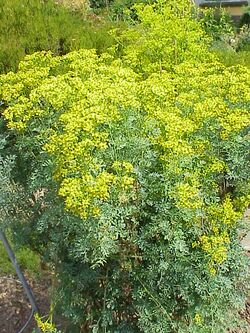Biology:Ruta
| Ruta | |
|---|---|

| |
| Ruta chalepensis, fringed rue | |
| Scientific classification | |
| Kingdom: | Plantae |
| Clade: | Tracheophytes |
| Clade: | Angiosperms |
| Clade: | Eudicots |
| Clade: | Rosids |
| Order: | Sapindales |
| Family: | Rutaceae |
| Subfamily: | Rutoideae |
| Genus: | Ruta L. |
| Species | |
|
See text. | |
Ruta (commonly known as rue) is a genus of strongly scented evergreen subshrubs, 20–60 cm tall, in the family Rutaceae, native to the Mediterranean region, Macaronesia and southwest Asia. About ten species are accepted in the genus. The most well-known species is Ruta graveolens (rue or common rue).
The leaves are bipinnate or tripinnate, with a feathery appearance, and green to strongly glaucous blue-green in colour. The flowers are yellow, with 4–5 petals, about 1 cm diameter, and borne in cymes. The fruit is a 4–5-lobed capsule, containing numerous seeds.
Species
(As of September 2021), Plants of the World Online accepted ten species:[1]
- Ruta angustifolia Pers.
- Ruta chalepensis L.
- Ruta corsica DC.
- Ruta graveolens L.
- Ruta lamarmorae Bacch., Brullo & Giusso
- Ruta lindsayi Turrill
- Ruta microcarpa Svent.
- Ruta montana (L.) L.
- Ruta oreojasme Webb
- Ruta pinnata L.f.
Medicinal uses
Extracts from rue have been used to treat eyestrain, sore eyes, and as insect repellent.[2][unreliable medical source?] Rue has been used internally as an antispasmodic, as a treatment for menstrual problems, as an abortifacient, and as a sedative.[3][unreliable medical source?] Ruta graveolens and Ruta chalepensis are often confused in scientific literature.[4]
Traditional uses
Since medieval times, rue has been used as an additive to wines (both white and red) to enhance its flavour and its keeping properties. The Dutch name wijnruit, translates as wine rue. In Italy, rue is added to grappa to produce Grappa alla Ruta. Rue's toxicity has long been known but since it appears to be slight it has been used as an additive in wine for a long time.
In Brazil, according to folk tradition said to have been brought by West African slaves, the rue plant – locally called arruda, in Portuguese – is claimed to protect against the evil eye.[5]
Precautions
Caution should be taken with using rue topically. Applied to the skin with sun exposure, the oil and leaves can cause blistering.[6] Some people are much more sensitive than others.
References
- ↑ "Ruta L.". Plants of the World Online. Royal Botanic Gardens, Kew. https://powo.science.kew.org/taxon/urn:lsid:ipni.org:names:35941-1.
- ↑ J. G. Vaughan; P. A. Judd (2006). The Oxford Book of Health Foods. Oxford University Press. ISBN 978-0-19-280680-2. https://books.google.com/books?id=WX7bHY98LAQC.
- ↑ J. G. Vaughan; P. A. Judd (2003). The Oxford Book of Health Foods. Oxford University Press. p. 137. ISBN 0-19-850459-4. https://archive.org/details/oxfordbookofheal0000vaug.
- ↑ Kannan R, Babu UV (July 2012). "Identity and pharmacognosy of Ruta graveolens Linn". Anc Sci Life 32 (1): 16–9. doi:10.4103/0257-7941.113792. PMID 23929988.
- ↑ altoastral. "Faça 5 simpatias com arruda para abrir caminhos e proteção" (in pt-BR). https://www.terra.com.br/vida-e-estilo/horoscopo/esoterico/faca-5-simpatias-com-arruda-para-abrir-caminhos-e-protecao,77d6be358d385690ff9767f581b1f99dn25iyfi9.html.
- ↑ Kimberly Eickhorst, Vincent DeLeo & Joan Csaposs (2007). "Rue the herb: Ruta graveolens-associated phytophototoxicity". Dermatitis 18 (1): 52–55. doi:10.2310/6620.2007.06033. PMID 17303046.
Wikidata ☰ Q165250 entry
 |



